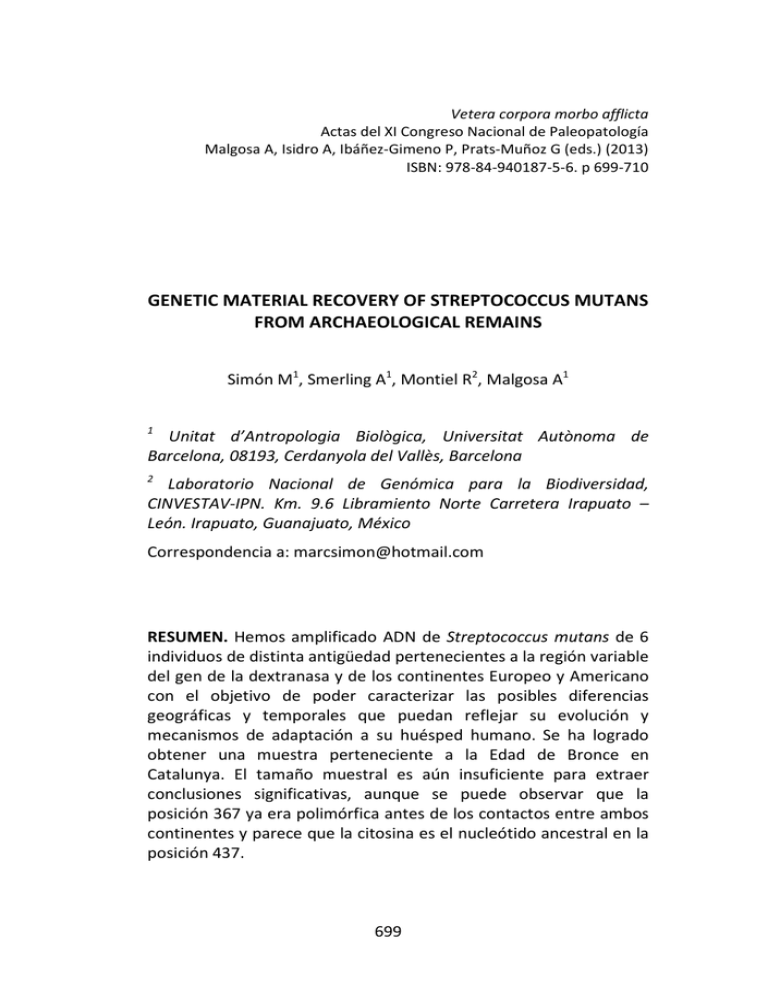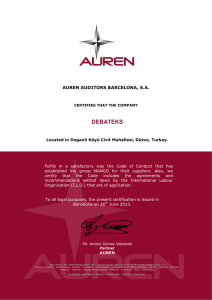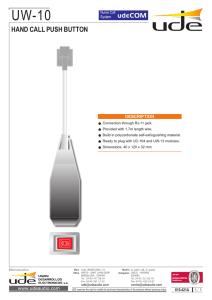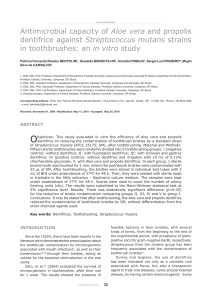genetic material recovery of streptococcus mutans from
Anuncio

Vetera corpora morbo afflicta Actas del XI Congreso Nacional de Paleopatología Malgosa A, Isidro A, Ibáñez-Gimeno P, Prats-Muñoz G (eds.) (2013) ISBN: 978-84-940187-5-6. p 699-710 GENETIC MATERIAL RECOVERY OF STREPTOCOCCUS MUTANS FROM ARCHAEOLOGICAL REMAINS Simón M1, Smerling A1, Montiel R2, Malgosa A1 1 Unitat d’Antropologia Biològica, Universitat Autònoma de Barcelona, 08193, Cerdanyola del Vallès, Barcelona 2 Laboratorio Nacional de Genómica para la Biodiversidad, CINVESTAV-IPN. Km. 9.6 Libramiento Norte Carretera Irapuato – León. Irapuato, Guanajuato, México Correspondencia a: [email protected] RESUMEN. Hemos amplificado ADN de Streptococcus mutans de 6 individuos de distinta antigüedad pertenecientes a la región variable del gen de la dextranasa y de los continentes Europeo y Americano con el objetivo de poder caracterizar las posibles diferencias geográficas y temporales que puedan reflejar su evolución y mecanismos de adaptación a su huésped humano. Se ha logrado obtener una muestra perteneciente a la Edad de Bronce en Catalunya. El tamaño muestral es aún insuficiente para extraer conclusiones significativas, aunque se puede observar que la posición 367 ya era polimórfica antes de los contactos entre ambos continentes y parece que la citosina es el nucleótido ancestral en la posición 437. 699 Simón et al. PALABRAS CLAVE: Dextranasa, Streptococcus mutans, Edad de Bronce ABSTRACT. We have amplified DNA from Streptococcus mutans from 6 individuals of different antiquity belonging to the variable region of the dextranase gene and from the European and American continents with the purpose of characterizing the possible geographic and temporary differences that can reflect their evolution and adaptation to its human host. It has been possible to obtain a sample belonging to the Bronze Age in Catalonia. The sample size is not enough to draw significant conclusions, even though it can be observed that position 367 was already polymorphic before the contact between the two continents and it seems that citosine was the ancestral nucleotide at position 437. KEYWORDS: Dextranase, Streptococcus mutans, Bronze Age INTRODUCTION Dental diseases have been widely overlooked along history at the time of explaining population dynamics in past populations, especially caries, the most widely extended buccal lesion, that is caused by Streptococcus mutans (S. mutans). The aim of this work is to start correcting this bias, the first step being the understanding of this microorganism’s evolution. (a) Streptococcus mutans’ characteristics This is the Gram-positive bacterium able to metabolize a widest variety of carbohydrates. It carries out a non-oxidative fermentation of these molecules, one of its major by-products being the lactic acid, that dissolves the enamel and thus can propitiate the caries (Quivey et al., 2001; Walsh, 2006). Owing to the acidification of the local environment, it inhibits its competitors because it has an acidstable membrane (Hamilton and Svensäter, 1998). The multilayer peptidoglican net, that does not have an external membrane, shows a high resistence to physical rupture and dry conditions, both of which favour its preservation (Quivey et al., 2001). 700 Simón et al. Apart from being the only species that has consistently been linked to human caries (Lindhe, 2001; Ajdic et al., 2002; Sato et al., 2003), it has recently been linked to heart problems (Janket et al., 2003). One of the systems used to classify the different strains of the microorganism is in groups called serotypes according to the biochemical characteristics of a peptidoglican chain that has a variable amount of glucose residues (serotypes c, e and f, Loesche, 1986) or a lack of them (serotype k, Nakano et al., 2004). Serotype c seems to be the most ancient and frequent one, and the appearance of the other three point to an evolution towards a reduction of its cariogenicity in favour of an increment in its sistemic virulence. No particular geographic distribution has been identified so far. According to the available data, its mode of evolution seems to be via horizontal transmission with an intraspecific genomic recombination, and its pattern of inheritance is matrilineal, although with a great degree of variation in percentage among individuals. A 5% of S. mutans populations bear a plasmid (Macrina and Scott, 1978) whose evolution does not parallel that of the rest of its chromosome (Caufield et al., 2007). So these data support that human beings, the bacteria and their plasmid have some characteristics typical of coevolution and others typical of independent evolution. It has also been observed a variation in its morphotypes according to its host pattern of subsistence. For this work, it is worth mentioning its production of the dextranase enzyme, a so-called virulence factor. It accumulates in the teeth via the accumulation of extracellular glucans synthesized from a sucrose molecule. This enzyme hydrolizes glucans, thus providing nutrients to the dental plaque bacteria (Colby et al. 1995; Igarashi et al., 2001, 2002), and modifies S. mutans molecular structure making its ligation to the plaque more adhesive (Igarashi et al., 2001, 2002; Morisaki et al., 2002). Preceeding this study, a member of our team showed that it was possible to recover S. mutans DNA from ancient remains (Smerling et al., 2005). 701 Simón et al. (b) Aims of the study The purpose of this study was to obtain S. mutans genetic material of samples that encompass from the Late Bronze Age to the XVth century in both the European and the American continents for ulterior studies, putting ready for the first time a protocol for its recovery from ancient remains. The pretention is to know wether its so-called virulence factors, as the one that codifies for the dextranase gene, have evolved along time. Finally, this study wants to check if the samples present at the New World show significant differences before and after the European colonization. (c) Ancient DNA problematics Normally, as a consequence of the passing of time and the damage that the genetic material suffers as a consequence to the exposure to various physical and chemical substances, the amount of DNA suitable for the amplification of amplicons of a correct size is very low. Moreover, UV iradiation or radicals present as a consequence of the oxidation can chemically modify the components of the DNA molecule, thus modifying the original sequence and creating modified, artificial ones. This is why repetibility in these studies is so important. A high amount of substances can, too, be inhibitory to the PCR reaction. A major problem in ancient DNA studies is the sample contamination with DNA coming from external sources, mainly from people that have manhandled them or by cross-contamination with samples previously treated at the same laboratory. Very strict measures are, though, ineludible: • Sterility: there has to be a physical isolation between the pre and postPCR areas, the conditions in the former must be of strict sterility and all the processes must be done with extreme care. • Whenever possible, depending on the sample number and conservation conditions, a percentage of the samples have to 702 Simón et al. be duplicated, both at the same laboratory and in an outer one. • Samples must make phylogenetic sense and a certain degree of diversity is a support for the authenticity of the results. So to authenticate the results, the recommended criteria concerning sterility, use of negative controls, reproducibility, clonation and diversity of the results were fulfilled. The flexibility and the intelligent use of these criteria were applied (Pääbo et al., 2004; Gilbert et al., 2005; Montiel et al., 2007). The BLAST program (Altschul et al., 1997) was used in GenBank database (NCBI) to compare the sequences. MATERIAL AND METHODS Samples were stored and amplified in the laboratory of palaeogenetics at the Universitat Autònoma de Barcelona. Conditions of sterility and the suitable precautionary measures were previously described elsewhere (Malgosa et al., 2005) A pair of primers from a segment from the dextranase gene that did not show homology with any other species were designed (Smerling et al., 2005), discarding the possibility of coamplification with any other microorganism, using the program BLASTN 2.2.9 in GenBank (Altschul et al., 1997) (Table 1). Specifically, an 84bp region from the N-terminal hypervariable segment was amplified. TABLE 1. Sequences of the primers used to amplify the 84bp studied segment L-344: 5’- CGGCTGAACCAGCTATTAGG -3’ Primer sequences (Smerling, 2004) R-467: 5’- GACGCCGATTCTGTCTGTAC -3’ (Smerling, 2004) Samples were carefully selected, diagnosing caries by the observation of dental pieces. 703 Simón et al. The extraction method was the phenol-clorophorm method used routinely at our laboratory (Malgosa et al., 2005). The amplification process consisted in an initial denaturation step at 94ºC, followed by 45 cycles of PCR, including 10 sec at 94ºC, 30 sec at the adequate annealing temperature, and a final high-resolution melting step. Individuals used were from different origins and periods (Table 2). TABLE 2. Origin and antiquity of the samples that were succesfully sequenced and the modern-day reference used Haplotip Situation Age North America Modern MO Montanissell, Lleida Bronze Age CR Can Reiners, Majorca VIIth cent SP Sant Pere Churches, Catalonia V-XIIth cent UA Catalonia XXth cent TL Tlatelolco, Mexico U159 1 2 3 4 5 Pre-cont XV-XVIth cent LO Los Olmos, Mexico 6 Post-cont XVIth cent 6 1 Pre-cont: pre-contact; Post-cont:post-contact; cent: century. Ajdic et al., 2002; 2 3 4 5 6 Simón et al., 2011; Díaz, 2009; Jordana, 2007; UAB collection; Solórzano, 2006. RESULTS 6 samples of 84bp were obtained, 4 from Europe (1 from the Bronze Age, 2 from the Middle Ages and 1 from the beginning of the XXth century), and 2 from America (1 from the XVth century, before the colonization process, and 1 from the XVIth century after it). The obtained sequences were aligned, together with a modern strain used as a reference (UA159, an American Strain, Ajdic et al., 2002) (Table 3). 704 . . . . SP UA TL LO . MO . T U159/AEO 14133 CR 364 Str./Acc. nr. 705 . A A . A . G 367 . . . . . . C 368 . . . . . . G 370 . . . . . . A 380 . . . . . . T 390 . . . . . . C 400 . . . . . . A 410 . . . . . . G 420 . . . . . . G 429 TABLE 3. Sequences obtained alligned with a modern-day reference . . . . . . G 430 C C C C C C T 437 . . . . . . C 440 . . . . . . A 447 Simón et al. Simón et al. There is an A to G transition at three of the samples at nucleotide position 367, and one of them is in an American sample preceding the European colonization, so this variation was already present in both Europe and America before this contact. The transition from C to T at position 437 that appears in the modern American sample has not yet been observed in the ancient samples, neither in the other modern samples sequenced so far (data not shown), so a C seems to be the ancestral nucleotide at this position. CONCLUSIONS As no positive controls and no S. mutans DNA had been previously used at our laboratory, we can verify the authenticity of our results and confirm that the isolation of DNA from this microorganism is possible in archaeological remains. Having recovered DNA from a sample belonging to the Bronze Age, it can also be established that this method is suitable to obtain positive results in prehistoric samples. More samples will be needed in order to know the evolution pattern of the virulence factors of S. mutans. Purposes for the future Considering the obtained results, it seems legit to think that in a few time palaeogenetics will be able to answer some of the following questions in the near future: • Were there changes in these bacteria when human beings moved from the hunter-gathering to the farming way of life? • Is S. mutans’ philogeny parallel to the one of its human host? What kind of evolution has this microorganism gone through? Do different ethnies relate to different paces in its evolution? • At what rythm has the bacterium been acquiring resources to adapt to the oral and cardiac environment of its host? • When and why did some strains acquire a plasmid? • Are the serotypic characteristics in Europe and America homogeneous? 706 Simón et al. This is just the starting point for the study of the palaeogenetics of this organism. BIBLIOGRAPHY Ajdic D, McShan WM, McLaughlin RE, Savic G, Chang J, Carson MB, Primeaux C, Tian R, Kenton S, Jia H, Lin S, Qian Y, Li S, Zhu H, Najar F, Lai H, White J, Roe BA, Ferretti JJ. 2002. Genome sequence of Streptococcus mutans UA159, a cariogenic dental pathogen. P Natl Acad Sci USA 99:14434–14439. Altschul SF, Madden TL, Schäffer AA, Zhang J, Zhang Z, Miller W, Lipman DJ.1997. Gapped BLAST and PSI-BLAST: A new generation of protein database search programs. Nucl Acid Res 25:3389-3402. Caufield PW, Saxena D, Fitch D, Li Y. 2007. Population structure of plasmidcontaining strains of Streptococcus mutans, a member of the human indigenous biota. J Bacteriol 189:1238-1243. Colby SM, Whiting GC, Tao L, Russell RRB. 1995. Insertional inactivation of the Streptococcus mutans dexA (dextranase) gene results in altered adherence and dextran catabolism. Microbiology 141:2929-2936. Díaz N. 2009. Bahía de Alcúdia, Mallorca: Un crisol genético en el Mediterráneo. PhD Thesis. Barcelona: Universitat Autònoma de Barcelona. Gilbert MT, Bandelt HJ, Hofreiter M, Barnes I. 2005. Assessing ancient DNA studies. Trends Ecol Evol 20:541-544. Hamilton IR, Svensäter G. 1998. Acid-regulated proteins induced by Streptococcus mutans and other oral bacteria during acid shock. Oral Microbiol Immun 13:292-300. Igarashi T, Yamamoto A, Goto N. 2001. Nucleotide sequence and molecular characterization of a dextranase gene from Streptococcus downei. Microbiol Immun 45:341-348. Igarashi T, Morisaki H, Yamamoto A, Goto N. 2002. An essential amino acid residue for catalytic activity of the dextranase of Streptococcus mutans. Oral Microbiol Immun 17:193-196. Jordana X. 2007. Caracterització i evolució d'una comunitat medieval catalana. Estudi bioantropològic de les inhumacions de les esglésies de Sant Pere. PhD Thesis. Barcelona: Universitat Autònoma de Barcelona. Lindhe J. 2001. Periodontología clínica e implantología odontológica. Madrid: Médica Panamericana. 707 Simón et al. Loesche WJ. 1986. Role of Streptococcus mutans in human dental decay. Microbiol Rev 50:353–380. Macrina FL, Scott CL. 1978. Evidence for a disseminated plasmid in Streptococcus mutans. Infect Immun 20:296-302. Malgosa A, Montiel R, Díaz N, Solórzano E, Smerling A, Isidro A, García C, Simon M. 2005. Ancient DNA: A modern look at the infections of the past. In: Pandalai SG, editor. Recent research developments in microbiology. Trivandrum: Research Signpost. p 213-236. Montiel R, Francalacci P, Malgosa A. Ancient DNA and biological anthropology: Believers vs. skeptics. 2007. In Santos C, Lima M, editors. Recent advances in molecular biology and evolution: Applications to biological anthropology. Kerala: Research Signpost. p 209-250. Morisaki H, Igarashi T, Yamamoto A, Goto N. 2002. Analysis of dextranbinding domain of the dextranase of Streptococcus mutans. Lett Appl Microbiol 35:223-227. Nakano K, Nomura R, Nakagawa I, Hamada S, Ooshima T. 2004. Demonstration of Streptococcus mutans with a cell wall polysaccharide specific to a new serotype, k, in the human oral cavity. J Clin Microbiol 42:198-202. Pääbo S, Poinar H, Serre D, Despres V, Juliane H, Rohland N, Kuch M, Krause J, Vigilant L, Hofreiter M. 2004. Genetic analyses from ancient DNA. Annu Rev Genet 38:645-679. Quivey RG, Kuhnert WL, Hahn K. 2001. Genetics of acid adaptation in oral streptococci. Crit Rev Oral Biol Med 12:301-314. Sato T, Matsuyama J, Kumagai T, Mayanagi G, Yamaura M, Washio J, Takahashi N. 2003. Nested PCR for detection of mutans streptococci in dental plaque. Lett Appl Microbiol 37:66-69. Simón M, Jordana X, Armentano N, Santos C, Díaz N, Solórzano E, López JB, González-Ruiz M, Malgosa A. 2011. The Presence of Nuclear Families in Prehistoric Collective Burials Revisited. The Bronze Age Burial of Montanissell Cave (Spain) in the Light of aDNA. Am J Phys Anthropol 146:406-413. Smerling A. 2004. Análisis de ADN de Streptococcus mutans recuperados en restos antiguos. DEA Thesis. Barcelona: Universidad de Barcelona. Smerling A, Chimenos E, Solórzano E, Díaz N, Montiel, R, Malgosa A. 2005. Analyse de l’ADN de Streptococcus mutans récupéré dans de restes anciens“. XLIX Congrès du GIRSO, Avr 21-23. Paris: Groupement 708 Simón et al. Internationale pour la Recherche Scientifique en Stomatologie et Odontologie. Janket SJ, Baird AE, Chuang SK, Jones JA. 2003. Meta-analysis of periodontal disease and risk of coronary heart disease and stroke. Oral surgery, oral medicine, oral pathology, oral radiology, and endodontics 95:559-569. Solórzano E. 2006. De la Mesoamérica Prehispánica a la Colonial: La huella del DNA antiguo. PhD Thesis. Barcelona: Universitat Autònoma de Barcelona. Walsh LJ. 2006. Dental plaque fermentation and its role in caries risk assessment. Int Dent SA Australasian Edition 1:4-13. 709



